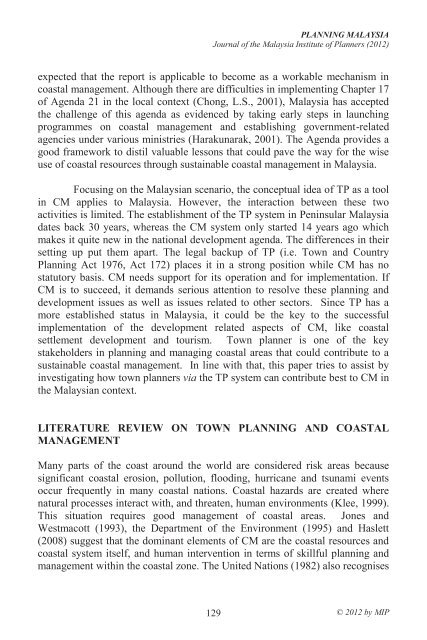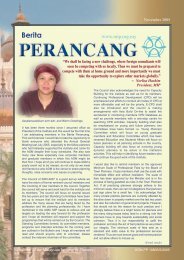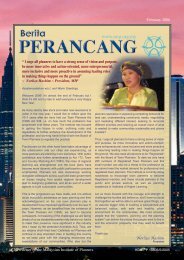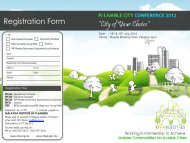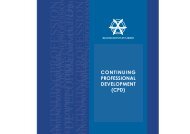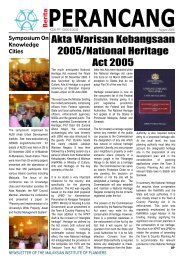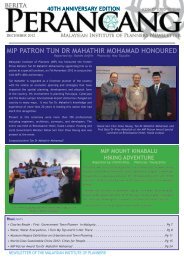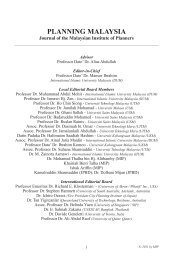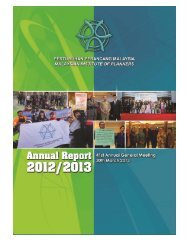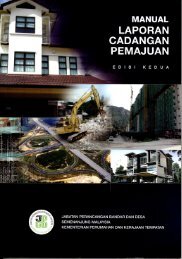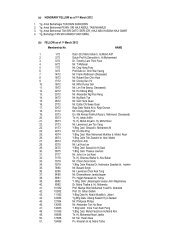Untitled - Malaysian Institute of Planners
Untitled - Malaysian Institute of Planners
Untitled - Malaysian Institute of Planners
Create successful ePaper yourself
Turn your PDF publications into a flip-book with our unique Google optimized e-Paper software.
PLANNING MALAYSIAJournal <strong>of</strong> the Malaysia <strong>Institute</strong> <strong>of</strong> <strong>Planners</strong> (2012)expected that the report is applicable to become as a workable mechanism incoastal management. Although there are difficulties in implementing Chapter 17<strong>of</strong> Agenda 21 in the local context (Chong, L.S., 2001), Malaysia has acceptedthe challenge <strong>of</strong> this agenda as evidenced by taking early steps in launchingprogrammes on coastal management and establishing government-relatedagencies under various ministries (Harakunarak, 2001). The Agenda provides agood framework to distil valuable lessons that could pave the way for the wiseuse <strong>of</strong> coastal resources through sustainable coastal management in Malaysia.Focusing on the <strong>Malaysian</strong> scenario, the conceptual idea <strong>of</strong> TP as a toolin CM applies to Malaysia. However, the interaction between these twoactivities is limited. The establishment <strong>of</strong> the TP system in Peninsular Malaysiadates back 30 years, whereas the CM system only started 14 years ago whichmakes it quite new in the national development agenda. The differences in theirsetting up put them apart. The legal backup <strong>of</strong> TP (i.e. Town and CountryPlanning Act 1976, Act 172) places it in a strong position while CM has nostatutory basis. CM needs support for its operation and for implementation. IfCM is to succeed, it demands serious attention to resolve these planning anddevelopment issues as well as issues related to other sectors. Since TP has amore established status in Malaysia, it could be the key to the successfulimplementation <strong>of</strong> the development related aspects <strong>of</strong> CM, like coastalsettlement development and tourism. Town planner is one <strong>of</strong> the keystakeholders in planning and managing coastal areas that could contribute to asustainable coastal management. In line with that, this paper tries to assist byinvestigating how town planners via the TP system can contribute best to CM inthe <strong>Malaysian</strong> context.LITERATURE REVIEW ON TOWN PLANNING AND COASTALMANAGEMENTMany parts <strong>of</strong> the coast around the world are considered risk areas becausesignificant coastal erosion, pollution, flooding, hurricane and tsunami eventsoccur frequently in many coastal nations. Coastal hazards are created wherenatural processes interact with, and threaten, human environments (Klee, 1999).This situation requires good management <strong>of</strong> coastal areas. Jones andWestmacott (1993), the Department <strong>of</strong> the Environment (1995) and Haslett(2008) suggest that the dominant elements <strong>of</strong> CM are the coastal resources andcoastal system itself, and human intervention in terms <strong>of</strong> skillful planning andmanagement within the coastal zone. The United Nations (1982) also recognises129© 2012 by MIP


